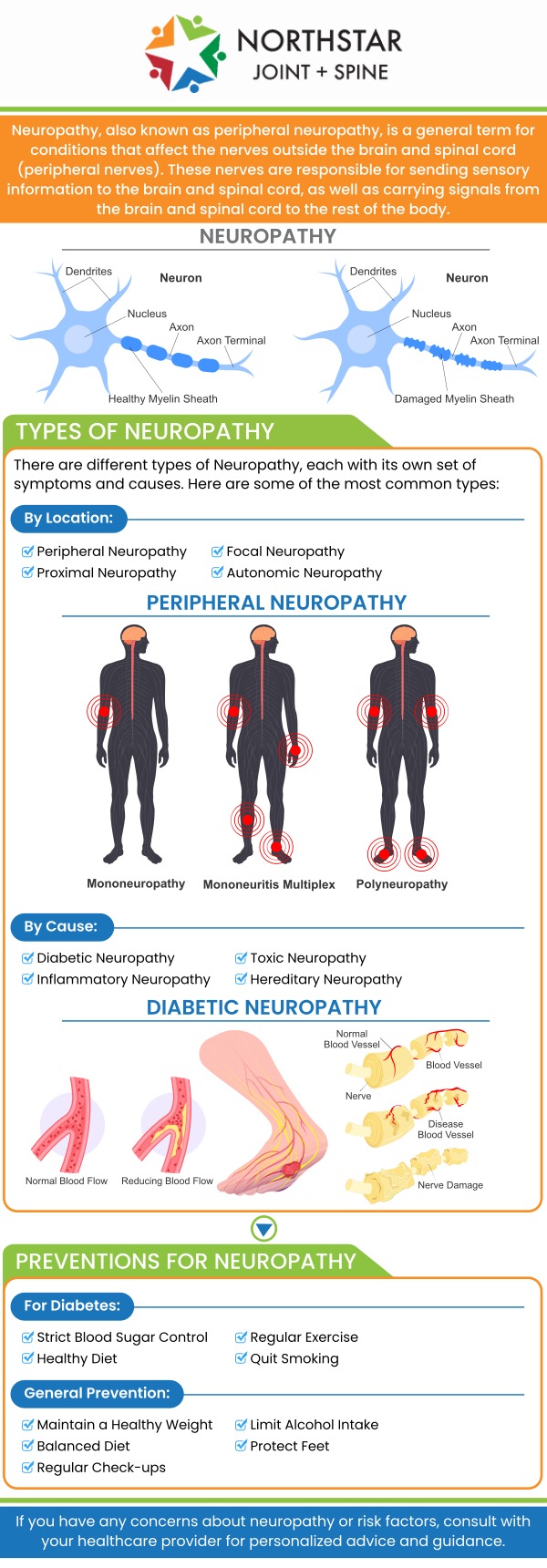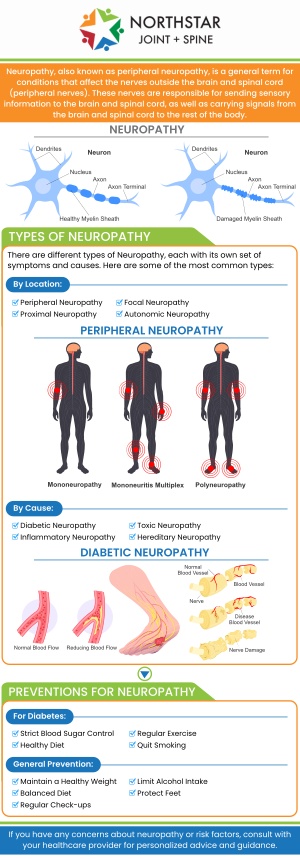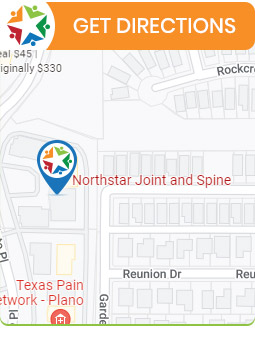Diabetic Neuropathy Treatment Doctor in Plano, TX
Diabetic neuropathy is nerve damage caused by high blood sugar levels, often affecting the feet and legs. Symptoms include numbness, tingling, and pain. This condition can lead to balance issues and increased sensitivity. Board Certified Dr. Robert J. Nocerini, MD, at Northstar Joint and Spine provides specialized care for diabetic neuropathy, focusing on personalized treatment plans to improve quality of life. For more information, contact us today or schedule an appointment online now! We are conveniently located at 7704 San Jacinto Pl Suite #200 Plano, TX 75024.


Table of Contents:
What is diabetic neuropathy?
What are the early signs of diabetic neuropathy?
What parts of the body does diabetic neuropathy affect?
What pain management strategies are effective for diabetic neuropathy?
Expert Diabetic Neuropathy Relief with Dr. Robert J. Nocerini, MD in Plano, TX
Diabetic neuropathy is a type of nerve damage that occurs as a complication of diabetes. It results from prolonged high blood sugar levels that harm nerves throughout the body, most commonly affecting the legs and feet. This nerve damage can cause symptoms such as numbness, tingling, burning sensations, and pain. Over time, the loss of feeling in the extremities increases the risk of complications and infections, which can become serious if not properly managed.
There are several types of diabetic neuropathy, with peripheral neuropathy being the most common. This primarily affects the feet and legs but can also impact the hands and arms. Other types include autonomic neuropathy, which affects nerves controlling internal organs, and focal neuropathy, which involves sudden weakness or pain in specific areas.
The exact cause of diabetic neuropathy involves complex metabolic and vascular factors, including poor blood flow to nerves and the damaging effects of high glucose on nerve fibers. Managing blood sugar levels carefully is essential to prevent or slow the progression of neuropathy. Symptoms can be managed through medications, lifestyle changes, and regular monitoring to avoid complications. Early detection and treatment improve quality of life and reduce the risk of serious problems related to diabetic neuropathy.
Early signs of diabetic neuropathy often develop gradually and can vary between individuals. Identifying these symptoms promptly allows for more effective management of the condition.
Common early signs include:
• Numbness or reduced ability to feel pain or temperature changes, especially in the feet and toes.
• Tingling or burning sensations that may begin in the toes or fingers and spread upward.
• Sharp, shooting pain or cramps, often worse at night.
• Increased sensitivity to touch, sometimes causing discomfort from even light contact.
• Muscle weakness or difficulty with coordination and balance, which can affect walking.
In some cases, early signs may also involve autonomic nerves, causing symptoms such as dizziness when standing up, digestive issues, or bladder problems. Because symptoms can be subtle initially, people with diabetes should regularly check their feet and report any unusual sensations to their healthcare provider. Early intervention can help slow progression and reduce complications.
Diabetic neuropathy primarily affects the nerves throughout the body, but most commonly involves the peripheral nerves in the feet and legs. This form, called peripheral neuropathy, often starts in the toes and progresses upward, sometimes reaching the hands and arms in a pattern known as “glove and stocking” distribution. Symptoms here include numbness, tingling, and pain.
Autonomic neuropathy affects nerves controlling involuntary bodily functions and can impact various organs such as the heart, digestive system, bladder, and blood vessels. This may cause symptoms like dizziness, digestive problems, urinary issues, or abnormal heart rates.
Focal neuropathy involves sudden weakness or pain in specific areas such as the head, torso, or legs. It can affect individual nerves or nerve groups, leading to localized symptoms.
Overall, diabetic neuropathy can affect multiple parts of the body, but the feet, legs, hands, digestive organs, and cardiovascular system are most commonly involved. Early detection in these areas is crucial to prevent complications.
Effective pain management for diabetic neuropathy involves a combination of approaches tailored to the individual’s needs. Controlling blood sugar levels is essential to slow nerve damage and reduce pain severity.
Medications commonly used include over-the-counter pain relievers, prescription nerve pain medications, which help reduce nerve pain signals.
Non-drug strategies are also important. Physical therapy and regular exercise can improve blood flow and reduce discomfort. Complementary therapies may help manage symptoms.
Lifestyle changes, including avoiding alcohol and quitting smoking, support overall nerve health. Patients should work closely with healthcare providers to create a personalized pain management plan that addresses both symptoms and underlying causes. Early intervention can improve quality of life and function.
At Northstar Joint and Spine, board-certified pain management physician Dr. Robert J. Nocerini, MD, provides advanced, personalized treatment for diabetic neuropathy. With 26 years of experience, Dr. Nocerini focuses on relieving burning, tingling, and numbness in the legs and feet through precision-based therapies that restore nerve health. His patient-first approach combines diagnostic accuracy with cutting-edge interventions to help Plano residents regain mobility and comfort.
Dr. Nocerini’s clinic offers comprehensive care designed to improve daily living while minimizing the need for long-term medications. Every treatment plan is customized to each patient’s condition and severity level. Plano patients trust Dr. Nocerini for his decades of expertise, compassionate care, and commitment to long-lasting nerve pain relief. For more information, contact us today or schedule an appointment online now! We are conveniently located at 7704 San Jacinto Pl Suite #200 Plano, TX 75024. We serve patients from Plano TX, Willow Bend TX, Frisco TX, Allen TX, Addison TX, North Dallas TX, and surrounding areas.

Additional Services You May Need
▸ Back Pain
▸ Chronic Pain
▸ Epidural Steroid Injections
▸ Spinal Cord Stimulation
▸ Viscosupplementation
▸ Genicular Nerve Blocks
▸ Facet Injections
▸ Joint Injections
▸ Sacroiliac Joint Injections
▸ Lumbar and Cervical
▸ Facet Medial Branch Blocks
▸ Diagnostic Nerve Blocks
▸ Medication Management
▸ Neck Pain Doctor
▸ Diabetic Peripheral Neuropathy
▸ Headaches
▸ Suboxone
▸ Botox for Migraines
▸ Peripheral Nerve Stimulation
▸ Spine
▸ Joints
▸ Muscles
▸ Bones

Additional Services You May Need
▸ Back Pain
▸ Chronic Pain
▸ Epidural Steroid Injections
▸ Spinal Cord Stimulation
▸ Viscosupplementation
▸ Genicular Nerve Blocks
▸ Facet Injections
▸ Joint Injections
▸ Sacroiliac Joint Injections
▸ Lumbar and Cervical
▸ Facet Medial Branch Blocks
▸ Diagnostic Nerve Blocks
▸ Medication Management
▸ Neck Pain Doctor
▸ Diabetic Peripheral Neuropathy
▸ Headaches
▸ Suboxone
▸ Botox for Migraines
▸ Peripheral Nerve Stimulation
▸ Spine
▸ Joints
▸ Muscles
▸ Bones






